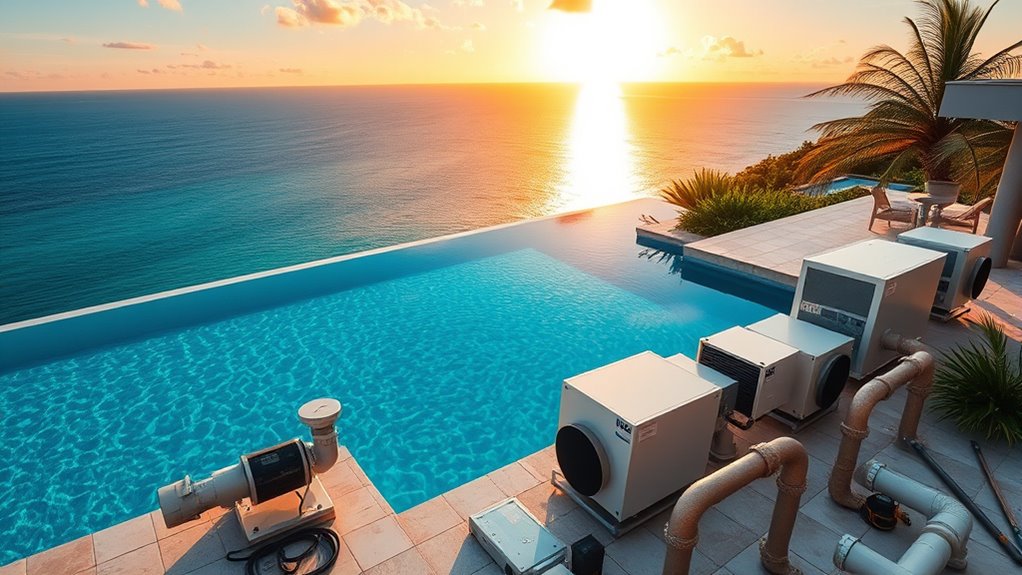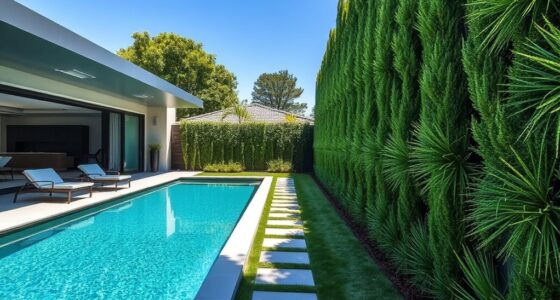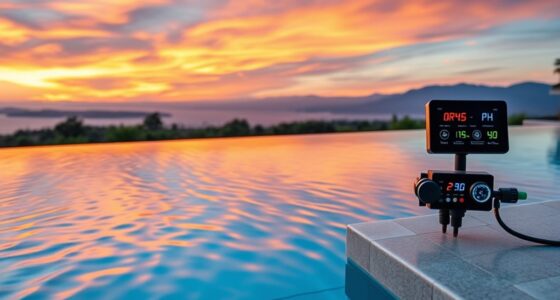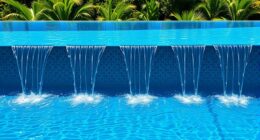Your infinity pool costs increase mainly due to design complexity, size, and customization choices. Unique shapes or intricate features like waterfalls and lighting drive up labor and material expenses. The location and site conditions, such as uneven terrain or poor soil, add prepared-ground costs. Structural needs and additional amenities, like fire pits or outdoor kitchens, also raise prices. Keep exploring to discover how permits and material selections can further impact your budget.
Key Takeaways
- Complex or custom designs, including unique shapes and features, significantly raise construction and materials costs.
- High-end materials and finishes, as well as advanced engineering, increase initial expenses and long-term maintenance.
- Site conditions like uneven terrain, poor soil, or obstructions require additional groundwork and increase labor costs.
- Additional features such as waterfalls, lighting, outdoor kitchens, and fire pits add substantial expenses.
- Regulatory compliance, permitting, and project management complexities can cause delays and unexpected cost increases.
Design Complexity and Customization

Design complexity and customization substantially influence project costs because more intricate designs require additional resources, time, and specialized skills. When you choose a unique shape, elaborate features, or custom finishes, you’re likely to see a cost increase. Complex designs often need precise engineering, advanced materials, and skilled labor, which all add to the budget. Custom features like waterfalls, lighting, or built-in seating also drive up expenses. The more personalized your pool, the more planning and craftsmanship it demands. These factors extend project timelines and increase labor costs, making your dream pool more expensive. Additionally, water quality considerations and the integration of specialized filtration systems can further impact costs. So, when planning your infinity pool, consider how much customization you want versus how it impacts your overall budget. Balancing design and cost helps you create a stunning pool within your financial plan.
Size and Shape of the Pool

The size and shape of your pool considerably impact the overall cost, as larger pools require more materials and labor, while unique or complex shapes often demand specialized craftsmanship. A bigger pool means more concrete, plumbing, and equipment, which quickly increases expenses. If you choose an irregular or intricate design, expect higher labor costs to achieve precise curves or custom features. Standard rectangular pools are generally more affordable because they’re easier to build and require less customization. Conversely, freeform or asymmetrical pools often involve additional planning, formwork, and skilled labor, all adding to your budget. Keep in mind that the more complex the shape, the more time and effort it takes to construct, directly influencing your total project costs. Additionally, pool design complexity can significantly influence the overall expense, as more elaborate designs typically require more detailed planning and execution.
Choice of Materials and Finishes

Choosing the right materials and finishes can substantially influence your pool’s overall cost and appearance. The options you select impact durability, maintenance, and aesthetic appeal, all of which affect your budget. For example, high-end materials tend to be more expensive initially but may save you money long-term through reduced upkeep. Additionally, considering effective marketing strategies can help you find reputable suppliers and installers that offer competitive pricing without compromising quality.
Location and Site Conditions
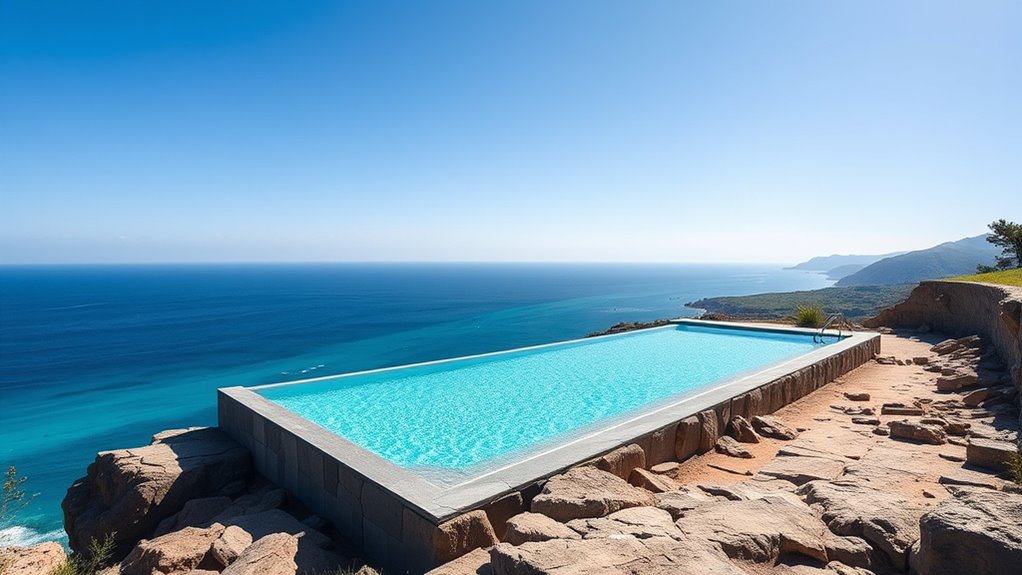
Have you considered how your site’s topography and soil conditions can impact your pool project? If your land is on a slope or uneven terrain, it may require extensive grading, which can considerably increase costs. Similarly, poor soil quality, like clay or loose dirt, might demand extra foundation work or soil stabilization, adding to your budget. Trees, rocks, or other obstructions can also complicate construction, leading to delays and higher labor costs. Additionally, if your site is far from access roads or utility connections, logistics become more complicated and expensive. These factors influence not just the initial build but also ongoing maintenance. Understanding your site’s conditions early helps you anticipate potential challenges and manage your budget more effectively. Conducting a soil analysis can provide valuable insights into how your site’s specific conditions may impact construction costs.
Structural Engineering Requirements

Understanding your project’s structural load demands helps you allocate your budget effectively. Choosing the right reinforcement materials can considerably impact costs and durability. By balancing these factors, you ensure a solid foundation without overspending. Additionally, consulting with a structural engineer can help identify appropriate spray techniques that optimize material use and reinforce the pool’s integrity.
Structural Load Demands
Structural load demands are fundamental to guaranteeing the safety and stability of a building, as they define the forces that the structure must withstand during both construction and operation. These demands influence your design choices and directly impact costs. Higher loads require stronger materials, thicker structural elements, and more robust foundations, all increasing expenses. Factors affecting load demands include:
- The weight of the infinity pool and water
- Live loads from occupants and furniture
- Wind and environmental forces
- Snow or ice accumulation, depending on location
- Future load considerations, like additional features
- Accurate assessment of these loads is essential for effective industry trend and cost management.
Understanding these demands helps you plan for appropriate structural support, avoiding overspending or under-designing. Proper assessment assures safety, code compliance, and cost efficiency, all crucial for managing your infinity pool project budget effectively.
Reinforcement Material Choices
Choosing the right reinforcement materials is essential for ensuring that your structure can handle the loads it faces while staying within budget. Opting for high-quality steel or advanced composites can improve durability and reduce long-term maintenance costs, but they often come with higher upfront expenses. Alternatively, using standard rebar may save money initially, but it might require more frequent repairs or replacements, increasing overall costs. Consider factors like tensile strength, corrosion resistance, and compatibility with concrete. Material choices also impact construction time; specialized reinforcements may need expert handling, adding labor costs. Balancing material performance with budget constraints requires careful evaluation of these trade-offs, ensuring your infinity pool remains structurally sound without unnecessary expenses. Additionally, understanding environmental considerations such as corrosion resistance can help select materials that are more sustainable and long-lasting.
Water Features and Additional Amenities
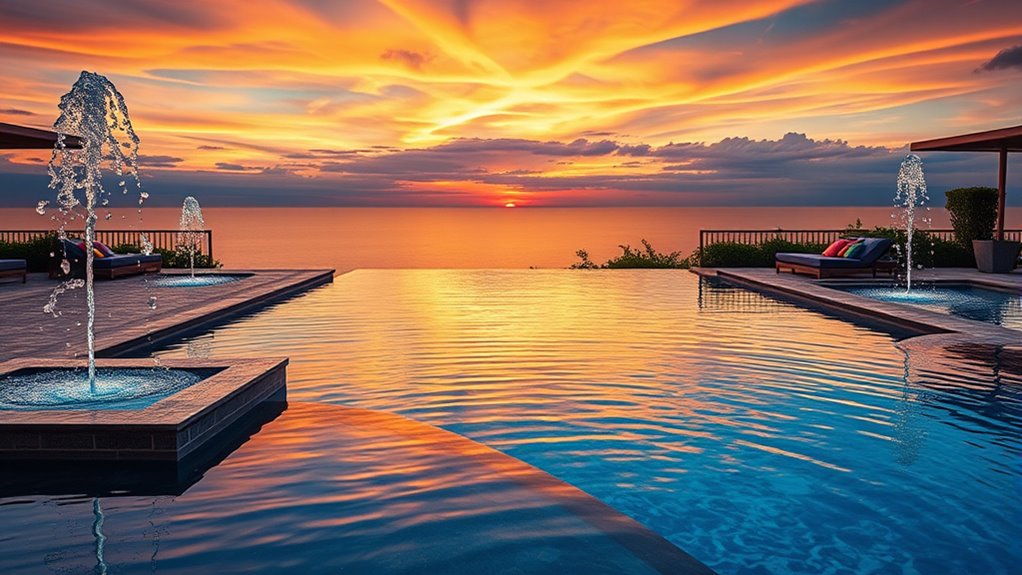
Water features and amenities can considerably impact your budget, especially when considering their complexity and design. You’ll also need to account for ongoing costs for maintenance and upkeep, which can add up over time. Understanding these factors helps you make informed decisions that balance aesthetics with financial planning. Incorporating multimedia storytelling can also enhance the appeal of your pool area, but it may require additional investment.
Water Feature Complexity
Have you ever considered how the complexity of water features impacts your overall budget? More intricate designs, like waterfalls, multi-tiered fountains, or river flows, considerably increase costs. Each element demands specialized equipment, installation, and ongoing maintenance. The complexity also affects the timeline, possibly causing delays and additional labor charges. Keep in mind, more elaborate features often require higher-grade materials and custom craftsmanship. Additionally, emotional readiness of the homeowner can influence the scope and design choices, especially if the project involves significant customization.
Additional Amenity Costs
Did you realize that adding amenities like water features, outdoor kitchens, or fire pits can notably boost your overall project costs? These extras often seem appealing, but they come with substantial price tags. Water features such as fountains or waterfalls require specialized equipment, plumbing, and electrical work, increasing installation costs. Outdoor kitchens involve durable materials, appliances, and custom cabinetry, which add up quickly. Fire pits or fireplaces need safety features and proper ventilation, further raising expenses. Additionally, these amenities may require permits, inspections, and professional installation, all contributing to the final bill. Proper planning and understanding of your space‑heating needs can help you prioritize which amenities are most valuable and avoid unnecessary expenses. While they enhance your outdoor space, it’s essential to budget for these extras early on, as they can significantly impact your overall project budget and timeline.
Maintenance and Upkeep
Adding amenities like water features, outdoor kitchens, or fire pits not only increases your initial project costs but also means committing to ongoing maintenance. These features require regular cleaning, inspections, and repairs to stay functional and attractive. Water features, in particular, demand consistent filtration and chemical balancing to prevent algae growth. Fire pits and outdoor kitchens need seasonal care to avoid rust and damage from the elements. Maintenance costs can quickly add up, impacting your budget long-term. Consider these factors:
- Regular cleaning and debris removal
- Equipment repairs and replacements
- Seasonal inspections and winterization
- Chemical and water treatment costs
- Potential professional service fees
Being prepared for these ongoing expenses helps you manage your budget effectively and enjoy your amenities without surprises.
Permitting and Regulatory Compliance

Permitting and regulatory compliance often represent significant cost drivers in project budgets because maneuvering complex approval processes can cause delays and unexpected expenses. You’ll need to navigate local, state, and federal regulations, which often involve multiple agencies with different requirements. Securing permits can take months, during which costs for site preparation, labor, and materials may accumulate unexpectedly. You might face fees for environmental impact assessments, zoning variances, or special use permits that weren’t initially budgeted. Additionally, compliance measures—like safety standards or water management protocols—can require costly modifications to your plans. Failure to secure proper permits or meet regulations can lead to fines or project shutdowns, further increasing costs. Planning ahead and working closely with regulatory officials helps minimize surprises and keeps your project on track financially.
Frequently Asked Questions
How Does the Geographic Climate Affect Infinity Pool Costs?
The geographic climate considerably impacts your infinity pool costs because hotter, sunnier areas require more cooling and maintenance, driving up expenses. If you’re in a colder or more humid region, you’ll spend more on insulation and heating systems. Windy or storm-prone locations also increase upkeep and repairs. Overall, climate influences your ongoing maintenance needs, energy use, and structural considerations, making your pool more costly to build and sustain.
Are There Eco-Friendly Options That Can Reduce Long-Term Expenses?
Yes, eco-friendly options can help cut long-term costs. You can opt for energy-efficient pumps, solar heating systems, and LED lighting to reduce energy consumption. Using sustainable materials for construction and incorporating natural filtration methods also lowers maintenance expenses. Installing covers or shades minimizes heat loss and evaporation, saving on water and heating costs. These choices not only benefit the environment but also lead to significant savings over the pool’s lifespan.
What Maintenance Costs Should I Expect Annually?
You can expect annual maintenance costs for your infinity pool to include regular water testing and balancing, filter and pump servicing, cleaning, and occasional repairs. Budget around 10-15% of your initial construction cost each year for upkeep. If you opt for eco-friendly systems, you might save on chemical expenses long-term, but keep in mind that certain eco upgrades could slightly inflate initial maintenance costs. Regular upkeep ensures your pool stays pristine and functional.
How Do Technology Upgrades Impact Overall Budget?
Technology upgrades can dramatically impact your overall budget, often feeling like trying to tame a wild beast. Upgrades may seem small initially but quickly add up, especially if you opt for the latest features or advanced systems. You could face unexpected expenses for hardware, software, installation, and ongoing maintenance. Planning for these costs and prioritizing essential upgrades helps control spending, ensuring your investment enhances your infinity pool experience without breaking the bank.
Can Financing Options Lower Initial Investment Costs?
Yes, financing options can lower your initial investment costs by spreading payments over time, making the project more affordable upfront. You can choose loans, leases, or payment plans that align with your budget, reducing the immediate financial burden. Just guarantee you understand the interest rates and terms involved, so you don’t end up paying more overall. Financing can make your dream infinity pool more achievable without sacrificing your financial stability.
Conclusion
Ultimately, understanding these budget drivers reveals that building an infinity pool can turn into an epic financial adventure—like commissioning a private island in your backyard. Every detail, from complex design to site-specific challenges, adds layers of cost that can make your dream seem more like a luxurious expedition than a simple project. So, brace yourself for the possibility that creating this stunning oasis might require a budget large enough to rival a small country’s annual expenditure.
